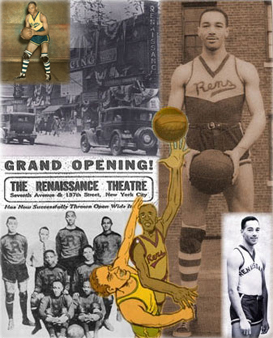
A look back at the Harlem Rens: “They’re Renaissance, Too”
By Gregory Lucas-Myers, Charles H. Wright Museum of African American History
The Harlem Renaissance is well-known as a period of African-American intellectual and cultural growth, centered in its namesake Manhattan neighborhood, during the 1920’s and 30’s. During this time, writers, musicians, artists, and leaders such as Zora Neale Hurston, Palmer Hayden, Dizzy Gillespie, and W.E.B. Du Bois came to popular prominence among the black urban populations growing in the country. One aspect of the Harlem Renaissance that is often overlooked, however, is another type of Renaissance, one that made its home in the hustle and bustle of a Harlem ballroom. Or rather, literally, it was made into a “ball” room.
It was the New York Renaissance. But, rather than being a citywide cultural movement, it was simply a group of men and the sport of basketball. The New York Renaissance, alternatively known as the Harlem Rens, were founded as a team in early 1923 by Robert “Bob” Douglas, in partnership with the Renaissance Casino and Ballroom. Hence, the earlier play on words; the Rens would use the establishment’s ballroom for games, setting-up portable hoops to turn the dance floor into a basketball court. Then, after the game was done, the rims would be packed away again and there would be dancing. Imagine the thrill of being able to enjoy a night of music and food after watching your hometown team defeat the competition, on the court they had just performed on! Well, the first thing that comes to mind for me would be the potential for odor, but I’m certain they cleaned up before the festivities.
Joking aside, the Rens were no joke in the sport. In their run from 1923 to their disbanding 1949, the team accumulated a stellar record of 2588 wins to 539 losses. In the 1932-33 season, they racked up a record of 88 consecutive wins, a record which has gone unmatched in professional leagues to this day. And make no mistake, the Rens were a professional team, going up against the likes of the Chicago Globetrotters (who would go on to make their home in Harlem), the Oshkosh All-Stars (whom the Rens would defeat to win the first invitational World Professional Basketball Tournament in Chicago in 1939), and had a very popular rivalry with the Original Celtics (no relation to those guys in Boston). In fact, during that incredible 88-straight-wins season, the Rens had a final record of 120-8, six of those losses came at the hands of the Original Celtics; the Rens responded in kind with eight victories over their fellow New Yorker rivals.
If this is reading like a sports article, it’s only because these numbers and facts are very relevant to the real point. Rising up in the midst of the fabled and much-studied Harlem Renaissance, the New York Renaissance basketball team was a squad of all-black players. Not only were they all-black, in contrast to other all-white independent teams including the Original Celtics and Oshkosh All-Stars, but they were an all-black professional organization which experienced tremendous success in the sphere of athletics. The New York Renaissance’s contributions to the evolution of African-American culture cannot be dismissed as simply a game, but must be recognized as the milestones they were.
Recent Content
-
Artsarticle ·
-
Artsarticle ·
-
Artsarticle ·

